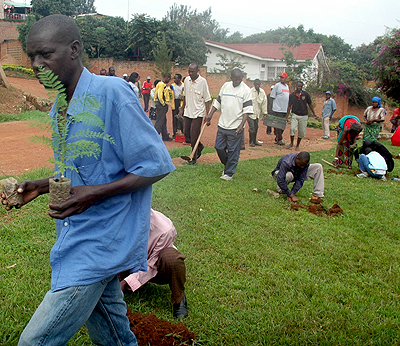Editor, The greatest threat to our planet is the belief that someone else will save it. It’s us the youth in charge of protecting our environment who should care and reach out to those that we will never meet.


Editor,
The greatest threat to our planet is the belief that someone else will save it. It’s us the youth in charge of protecting our environment who should care and reach out to those that we will never meet. Natural and cultural diversity is obviously our main asset and its protection requires solidarity and joint actions.
Special common strategies need to be implemented regarding environmental protection in the fields of archeology, ethnography, traditional arts and crafts.
Rwanda’s green landscape and archaeological sites represent not only a store of knowledge about our human past, but also score as a major asset for conservation and understanding of nature.
Fauna and flora sites provide living space for birds, animals, plants and also inhabit a wide range of natural sites adapted to life a alongside man. The dominance of machines over humanity and nature has altered environments and landscapes on a scale that is staggering and we are witnessing a real crisis that is not one of scientific principle but of wrong choice.
This has created an alarming gap that needs to be filled with far reaching contribution to a better understanding of people and nature and to a better and a more balanced relationship between the two. This can be done through re-orienting and altering attitudes to the natural environments in which we live.
That is, to instill that kind of man-nature, living a non-destructive manner. This will leave behind a profound impact on personal identity and on a country’s social, economic and ecological developments by creating an ideal partnership between man and nature, respect for local diversity in both botanical and culture.
This will definitely highlight and bring out our close ties to the environment and work with natural resources to stimulate sustainable forms of development and help societies that nurture positive relation to nature.
There is need to demonstrate significant interactions between culture and nature, introduce new ideas and approaches to environmental issues because our relation to nature is key to the creative process.
We would like to see a green museum incorporating concepts that interprets sustainable practices that present model behaviour, helping people to become conscious of their world, its limitations and how our actions affect it. This can be only possible by imposing a positive change and encouraging people to make sustainable choices in their daily lives.
Culture and nature introduce new ideas and approaches to environmental issues to stimulate sustainable forms of development that reveal the impact culture in innovative ways that help societies.
Now, green museum (environmentally thought practice) come at our rescue with a unique role to establish and promote a culture of sustainability that holds the deepest values, attitudes and actions on the environment with an equaled power and responsibility to model and teach the methods of preserving ourselves, our planet and our cultural resources.
The environment can live without humans but human beings cannot live without the environment and, as a matter of fact, when we lose nature’s image we lose our life, the presence of nature is ideal to man’s self thus need to get closer in that kind of ideal partnership and treat our environment in a more relevant way.
The option of creating reserves, conservation and eco-museums in Rwanda would be more profitable in terms of increasing quality of life and needs dedicated structures as well as high quality conservation management.
David Nkusi, Rwanda
Reaction to the story, "Rema banks on youth for environmental protection” (The New Times, January 28)


